¶ 1. What is SMPTE ST 2110
¶ 1.1 Background of ST 2110
With the development of digital technology, the demand for higher quality and more flexible audio and video transmission schemes is increasing in all walks of life. Traditional video interfaces, such as SDI/ HDMI/ DP, gradually show limitations (bandwidth, transmission speed and decoding ability) in dealing with high resolution, high frame rate and multi-channel audio. To solve these problems, SMPTE (Society of Motion Picture and Television Engineers) initiated the formulation of ST 2110 standards, which is the technical basis for achieving the goals of media convergence, cloud computing and big data analysis in the future.
At present, the common optical fiber transmission ST 2110 bandwidth on the market is 25G, 40G and 100G. Because the 25G interface is the most economical and the technology is relatively mature, it is the most widely used. As for 40G, its transmission speed is slower than 100G, while its cost is not low. So its application is rare. 100G is equivalent to four 25G bandwidth, and four 25G technologies are integrated together, which is the first choice for large bandwidth now.
¶ 1.2 Detailed Explanation of ST 2110
SMPTE ST 2110 is a set of professional audio and video transmission standards based on an IP network, which is formulated by the Society of Motion Picture and Television Engineers (SMPTE). ST 2110 is the general name of a set of protocols. The SMPTE ST 2110 standard includes many parts, mainly involving video, audio, and system timing. The following are its main components:
- SMPTE ST 2110-10: System Specification and System Timing
System-level specification, which defines the requirements for synchronizing video and audio streams in IP-based media networks clock and time standard. The processing of time is determined by ST2059 standard and ST 2059 edition. PTP is used to realize time sync. Part of ST 2110-10 defines clock synchronization based on PTP to ensure that the time stamps of audio and video streams are synchronized, to synchronize audio and video correctly.
- SMPTE ST 2110-20: Uncompressed Video
The transmission mode of the video stream in an IP-based network is specified, including video frame format, compression mode, and other related parameters.
- SMPTE ST 2110-30: Uncompressed Audio
The transmission mode of the audio stream in an IP-based network is defined, including channel configuration, sampling rate, bit depth, and other audio-related parameters.
- SMPTE ST 2110-40: Synchronous Data
Define how to carry auxiliary data. All supplementary items related to commercial value-added services of video, such as advertising queues, closed captions, and time codes were not usually embedded in SDI blanking before, but IP systems did not have SDI. So, this standard was born.
¶ 1.3 Why 25G/100G Ports
ST2110 system supports HD, 4K, 8K, and even 16K in the future, why the IP interface of ST2110 devices at this stage is mainly 25G/100G ports?
- Market demands
With the popularity of 4K and 8K UHD video, the demand for bandwidth is also increasing. 25G and 100G Ethernet technologies provide higher bandwidth for ultra-high-definition video transmission.
- Technology maturity
25G and 100G Ethernet technologies are relatively mature and widely used in data centers and enterprise networks. This allows the ST 2110 device to leverage existing Ethernet infrastructure, reducing cost and complexity.
- Technology maturity
25G and 100G ports offer cost advantages compared to higher-speed ports, such as 400G. At the same time, they provide enough bandwidth to meet the needs of most media delivery applications.
- Compatibility
25G and 100G Ethernet technologies are compatible with existing network equipment and protocols, enabling smooth upgrades and transitions.
¶ 2. Application Scenarios of ST 2110
¶ 2.1 Broadcasting & TV Production
ST 2110 provides uncompressed audio and video transmission for broadcasters and TV producers. This high-quality transmission mode meets the requirements of TV stations, broadcasters, and media production companies for high definition, high frame rate, and multi-channel audio. Its flexibility and extensibility enable the production team to adapt to the requirements of different projects more easily and improve production efficiency.
¶ 2.2 Live Events & Sports Events
In the field of digital streaming media such as live events and sports events, concerts, etc., the separation and transmission characteristics and clock synchronization characteristics of ST 2110 are very important for multi-camera shooting and audio and video synchronization. This enables producers to process and mix various signals in real time. Lossless compression of audio and video transmission mode is particularly important for large-scale stage rental customers to meet their application scenarios with high requirements for audio and video quality.
¶ 2.3 Remote Production & Collaborative Work
The ST 2110 standard based on IP makes remote production more feasible. Audio and video signals can be accessed and managed remotely between buildings through the network, and large companies can achieve collaborative work, and high-quality transmission of signals without delay and compression, which reduces the restrictions of geographical location of work; Uncompressed and separated audio and video streams make teaching materials clearer for educational institutions, while flexibility helps to adapt to different teaching needs.
¶ 2.4 Government Projects
With ST 2110, the video source is transmitted through the all-optical network, which ensures the security of the video source and effectively prevents stealing and tampering with the video source information. Since the ST 2110 standard is an open standard, it has strong compatibility which supports different manufacturers’ equipment to work together in the same network, without the need for third-party software installation, and it is irreplaceable for other schemes that bring advantages to the government, insurance, and security institutions.
¶ 3. System Composition & Hardware Framework of ST 2110
The hardware framework of LED system with ST 2110 in the market mainly involves video and audio processing unit, network switching equipment, clock synchronization system, and LED controller with ST 2110 input.
The system topological map is as follows:
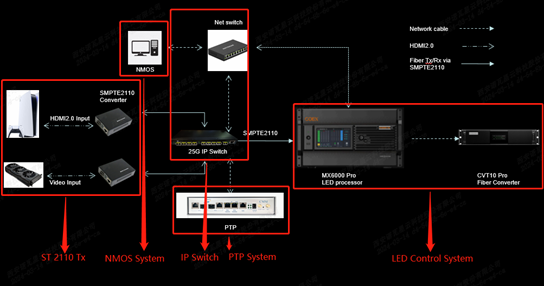
¶ 3.1 Video Processing Unit
- The Graphics Card Directly Outputs Optical Signals.
The biggest difference between the graphics card NVIDIA BlueField-2 DPU on the left and the conventional graphics card is that the output interface of NVIDIA BlueField-2 DPU is an optical fiber port, and the graphics card can directly transmit optical signals.
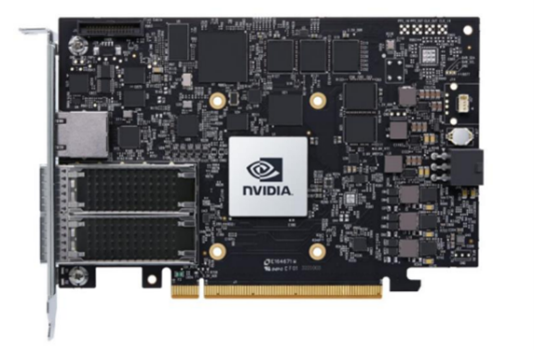
- A Converter for Converting Video Signals into Optical Signals
Below Pic shows the dual-channel SFP HDMI-to-IP converter, which can convert the traditional video input into optical signals to achieve ST 2110 protocol transmission.
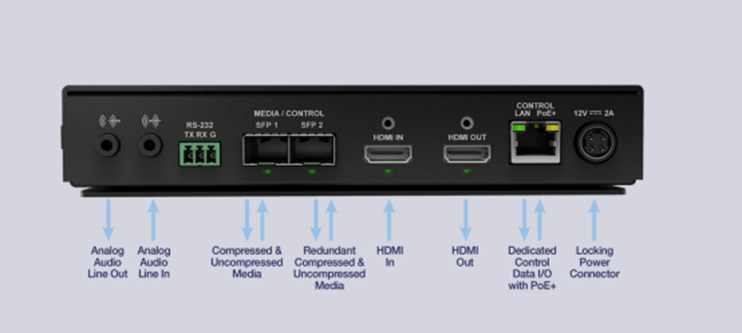
¶ 3.2 Audio Processing Unit
- The Graphics Card Transmits Audio Directly
The audio processor converts the audio signal format to ensure the quality of the audio stream and format to comply with ST 2110 standard.
¶ 3.3 Network Switcher
- Adopt IP Network Switcher to Transmit Audio and Video
- Adopt Optical Signal Switcher to Transmit Audio and Video
¶ 3.4 Clock Synchronization System
The Genlock is used to synchronize signals in the traditional video transmission process. In the IP streaming media, ST 2110 requires all devices in the network keep accurate clock synchronization, so it is necessary to use professional clock synchronization equipment, for example, PTP GM(Grandmaster), an optical /IP switcher integrated with PTP system.
¶ 3.5 Control Unit
Used to manage the equipment in the whole ST 2110 system, usually it is a computer which installed NMOS software to control all the equipment in the system, as shown in figure.
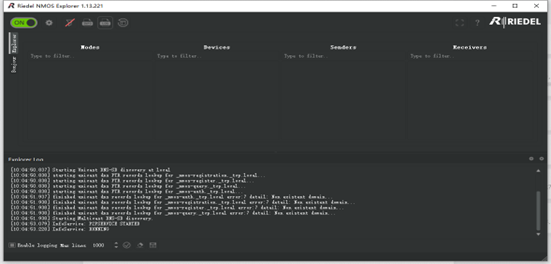
¶ 3.6 Storage System
Storage system is optional but currently not supported (Last update: March 2024)
For application scenarios that need audio and video recording and storage, it may be necessary to integrate the storage system to meet the requirements of long-time recording and playback.
¶ 4. Advantages of ST 2110 Transmission
¶ 4.1 Solve the Transmission and Dispatching of High Bandwidth Signals
The traditional system adopts SDI infrastructure of coaxial cable to transmit 270Mbps SD and 1.485Gbps/3Gbps HD, which is very mature and stable. However, SDI infrastructure technology is not enough to handle the ultra-high definition such as 4K and 8K. ST 2110 has high bandwidth and high transmission speed, which can cover the blank of the field.
¶ 4.2 Change the Limitation of Linear Transmission from Front-end to Back-end
Traditional radio and television signals can only be transmitted linearly from front-end to back-end, but ST 2110 data is transmitted in the form of data package, and any data package can be used independently in multiple receiving terminals, which is the technical basis for realizing the goals of media convergence, cloud computing and big data analysis in the future.
¶ 4.3 Simplify the Solution
Compared with the traditional encoder-to-decoder architecture, it can save the cost of encoder and decoder equipment because the graphics card or input source can directly output IP streaming video.
¶ 4.4 High Quality Video Source
Support compressed and uncompressed video transmission, with low latency resolution up to 8K, and good extensibility.
¶ 4.5 High Transmission Efficiency and High Flexibility
For devices that only provides subtitles, all parts of the ST 2110 signal are transmitted separately, such as video, audio, and auxiliary data. There is no need to receive several Kbps data by receiving several Gbps data.
¶ 4.6 High Compatibility
Support the interaction of products with NMOS protocol, and devices conforming to ST 2110 standard can establish the relationship of multicast joining and routing with any third-party IP devices with different brands of great compatibility.
¶ 4.7 Support PTP Synchronization.
PTP ensures that all the data in the network can be transmitted and received normally. Since system synchronization is very important, the IP production system uses the PTP network accurate clock as the synchronization benchmark.
¶ 5. Market Development Trend of ST 2110
The development of SMPTE ST 2110 standard in the market is booming, and it has been widely used in broadcasting, TV production, sports events, music performing arts and other fields. Main factors affecting the development trend of ST 2110 market are as follows:
¶ 5.1 Growth of Digital Media Production
With the rapid growth of digital media, the demand for high-quality, flexible, and extensible audio and video solutions is also increasing. As a professional audio and video transmission standard supporting IP network, ST 2110 standard can adapt to the ever-changing digital media production environment.
¶ 5.2 Popularization of High Definition and HDR Technology
The wide application of high definition and HDR technology in broadcasting and production has prompted the industry to seek more advanced audio and video transmission standards. The flexibility and multi-format support of ST 2110 make it an ideal choice to meet these high-quality requirements.
¶ 5.3 Improvement of IP Network Infrastructure
With the improvement of IP network infrastructure, including higher bandwidth, lower latency and more stable network connection, the implementation of ST 2110 becomes more feasible. This provides more choices for the audio and video industry to gradually migrate to the IP-based workflow.
¶ 5.4 Increased Remote Production and Collaboration
The demand for remote production and collaboration is increasing, especially on a global scale. ST 2110 supports the remote transmission of high-quality audio and video, making it a powerful technology in remote production.
¶ 5.5 Transformation of Broadcasting Industry
The traditional broadcasting industry is undergoing digital transformation, including the transformation from SDI to IP. The ST 2110 standard plays a key role in this process, helping broadcasters to achieve a more efficient, flexible, and extensible production process.
¶ 5.6 International Recognition of Standards
ST 2110 standard has been supported and promoted by SMPTE and has been widely recognized by the industry. This is helpful for the popularization and application of standards in different markets.
¶ 5.7 Continuous Investment and Innovation from Suppliers
Suppliers of hardware and software solutions related to ST 2110 are constantly investing and innovating to provide more advanced and reliable products. This will help ST 2110 to meet the market demand and promote its adoption in various fields.
¶ 6. NovaStar’s ST 2110 Solution
¶ 6.1 Hardware Introduction for 25G &100G Input Cards
MX_1×ST2110 (25G) input card is on sale, which has one primary port and one backup port;
MX_2×ST2110 (25G) input card is on sale, which has two primary port and two backup port.
And 100G Input Card is still under development.
See the following table for interface specifications of ST 2110 (25G) input card:
|
Input |
Interfaces |
Details |
|
|
ST2110 (25G) |
One Primary Port and One Backup Port |
Standard |
Supporting SMPTEST2110 (-10,20), SMPTE2059 (-1, -2) standards. |
|
Backup |
Supporting SMPTE2022-7 standard. |
||
|
Resolution |
Maximum resolution 4096*2160@60Hz. |
||
|
SDP Management |
Supporting VESA standard input resolution. |
||
|
NMOS Management |
Discovery and control of NMOS based on IS-04 and IS-05 standards. |
||
|
Color Gamut |
BT.601/BT.709/BT.2020. |
||
|
IP Address |
IPv4 DHCP and static IP. |
||
|
Multicast Protocol |
IGMPv3, IGMPv2 |
||
|
Ethernet Connection |
25GbE IEEE 802.3cc (25GBASE-LR) 25GbE IEEE 802.3by (25GBASE-SR) |
||
¶ 6.2 Features & Advantages
- 2 Primary and 2 Backup Input card
Supports 2 real 4K inputs (4K@60Hz, 10bit, 4:4:4 video source input);
MX6000 Pro supports 16 channels of ST 2110 25Gbps SFP28 interface. This input card can support 2 channels of 4K inputs with high resolution, high frame rate, high color depth the backup function and supports the ST2022-7 standard, which can realize seamless switching between the primary and backup video sources and realize real non-inductive backup.
- Security of Video-over-IP Solution
It supports software-defined video source switching while ensuring the security of video sources, making the assembly process more user-friendly. The attribute of ST 2110 card can be controlled and managed by NMOS software and COEX VMP so that the user can do the configurations by both NMOS software and VMP.
- Flexibility
Extensible IP network technology replaces traditional SDI transmission, which significantly reduces the cost of wire and video switchers.
- Low Latency
Precise Time Protocol (PTP) achieves nanosecond precision synchronization, ensuring low latency display and synchronization.
¶ 6.3 NovaStar’s Unique Advantages
- MX6000 Pro adopts modular design
•Flexible and simple to manage
•Powerful capacity up to 141 Million pixels
- Backup design adds extra system reliability
•2×4K 10bit @60Hz inputs
•One primary and one backup
- Independent R&D
•Open to customization
- Quick response in service
•Provide configuration guidance with 100+ FAE globally.
¶ 6.4 Solution Topology
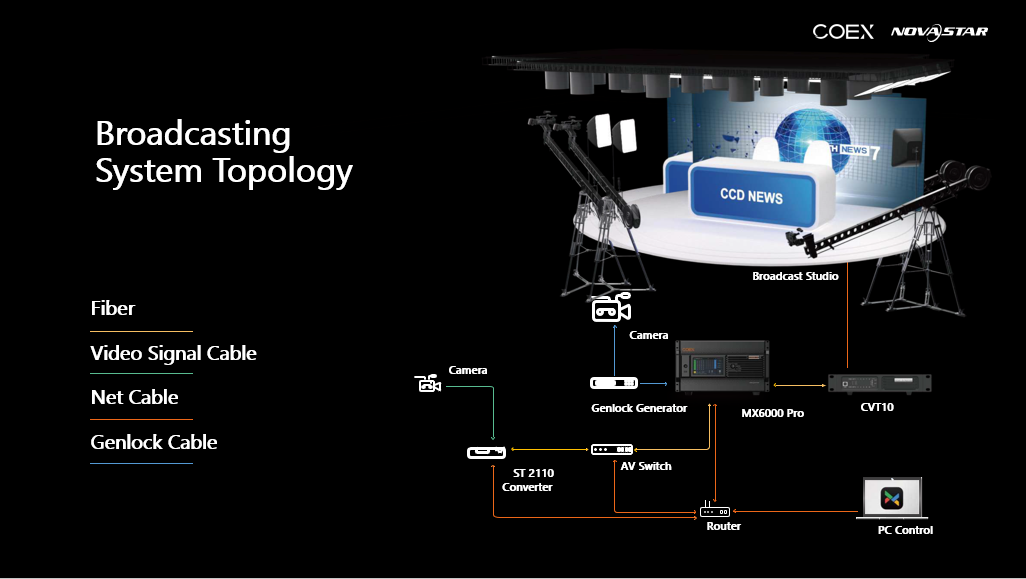
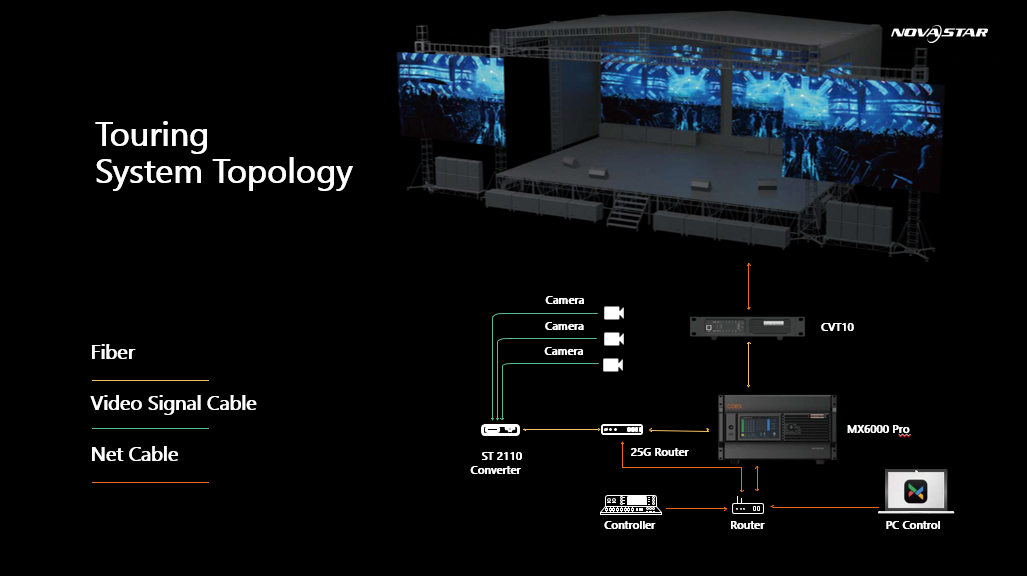
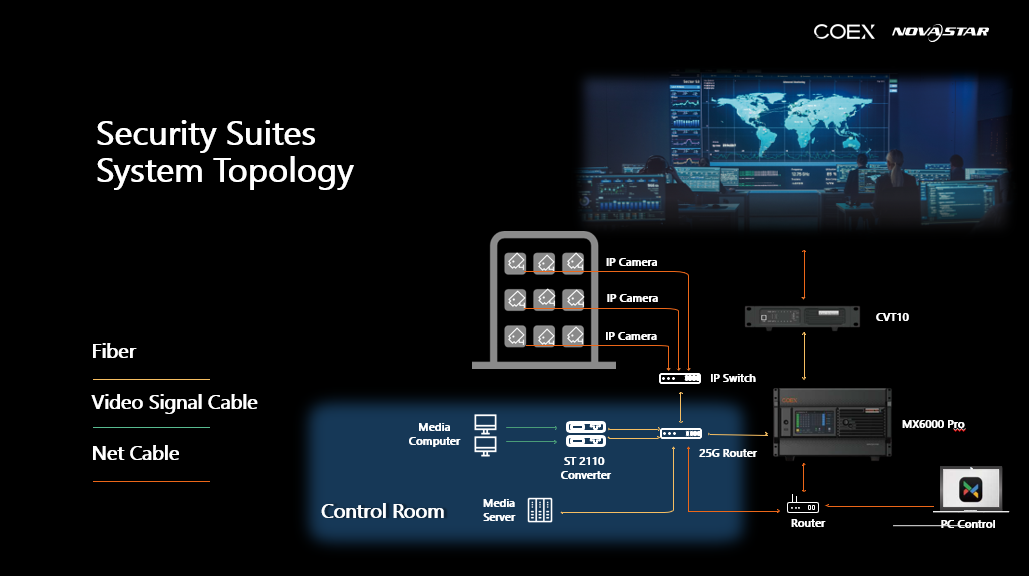
We consistently enhance and refine the content of our Wiki articles.
If you find any mistakes or errors, please contact us.
Your continuous feedback and support will help us further improve our products and content.